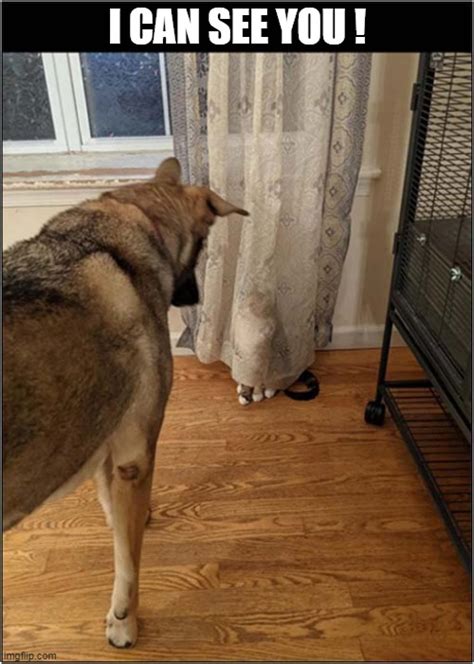
A pug’s hilariously flawed attempt at hide-and-seek in a local park has gone viral, bringing joy to internet users worldwide. The diminutive dog, whose efforts at concealment were thwarted by its own stumpy legs and conspicuous tail, has become an overnight sensation, proving that even failed attempts can be a source of pure amusement.
The viral video, initially posted on social media, captures the pug’s earnest yet unsuccessful efforts to hide behind a slender tree. Despite its best intentions, the pug’s rear end remained clearly visible, wagging its tail with oblivious enthusiasm. The comical scene quickly spread across various online platforms, garnering millions of views and sparking a wave of lighthearted commentary.
According to the Yahoo Lifestyle article, the video exemplifies the inherent charm and comedic timing often displayed by pugs. “Pugs, known for their expressive faces and quirky personalities, have a knack for turning everyday activities into sources of entertainment,” the article stated. This particular pug’s hide-and-seek blunder perfectly embodies this characteristic, resonating with viewers who appreciate the breed’s endearing qualities.
The incident has also sparked discussions about the unique physical characteristics of pugs, particularly their brachycephalic (short-nosed) features and their impact on their behavior. While these features contribute to their distinctive appearance, they can also present challenges, such as breathing difficulties and limited agility. In this case, the pug’s short legs and compact build undoubtedly hindered its ability to effectively conceal itself.
However, the video’s popularity underscores the importance of responsible pet ownership and awareness of breed-specific needs. While the pug’s hide-and-seek fail is undoubtedly amusing, it also serves as a reminder of the responsibility that comes with owning a brachycephalic breed, including providing appropriate care and addressing potential health concerns.
Beyond the immediate amusement, the viral video has also highlighted the power of social media to connect people through shared experiences of joy and laughter. In a world often dominated by negativity and conflict, the pug’s innocent antics have provided a welcome respite, reminding viewers of the simple pleasures in life.
The video has also spurred a trend of similar pet-related content, with users sharing their own comical experiences with their furry companions. This underscores the universal appeal of animal antics and the ability of pets to bring people together through shared laughter. The pug’s hide-and-seek fail is not just a funny video; it’s a cultural phenomenon that reflects our appreciation for the unique qualities of animals and their ability to brighten our lives. It’s a reminder that sometimes, the most joyful moments are found in the simplest of things, like a pug’s earnest attempt to hide behind a tree.
Expanded Details and Context:
The internet has a penchant for turning ordinary moments into viral sensations, and this pug’s attempt at hide-and-seek is a prime example. What sets this video apart is not just the inherent cuteness of the pug, but also the relatability of the situation. Anyone who has ever played hide-and-seek, whether as a child or with a pet, can appreciate the pug’s earnest efforts and the comical results.
Pugs, with their wrinkly faces, bulging eyes, and curled tails, are already inherently expressive creatures. Their facial expressions often seem to convey a range of human emotions, making them particularly appealing to online audiences. This inherent expressiveness, combined with their tendency for clumsy antics, makes them ideal candidates for viral fame.
The video’s success can also be attributed to its simplicity. There are no special effects, no elaborate setups, and no complex storylines. It’s simply a pug trying to hide, and failing miserably. This simplicity allows viewers to focus on the core comedic element: the contrast between the pug’s intention and its execution. The dog clearly wants to hide, but its physical limitations make it impossible to do so effectively.
The fact that the pug’s tail is wagging throughout the attempt further enhances the humor. The wagging tail suggests that the pug is completely oblivious to its own lack of success, adding to the sense of innocent amusement. It’s as if the pug is saying, “I’m doing my best, and I’m having fun, even if I’m not very good at this.”
The viral spread of the video also underscores the power of social media algorithms. Platforms like TikTok, Instagram, and Twitter are designed to amplify content that is likely to engage users. Videos that are funny, cute, or relatable are often prioritized in these algorithms, increasing their chances of going viral. In this case, the pug’s hide-and-seek fail ticked all the boxes, resulting in widespread sharing and engagement.
However, the video’s popularity also raises important questions about the ethics of sharing animal-related content online. While most viewers are likely to find the video harmless and amusing, it’s important to consider the potential impact on the pug itself. Will the pug be subjected to unwanted attention or harassment as a result of its newfound fame? Will its owners be able to protect its privacy and well-being? These are important questions that need to be addressed as we continue to share and consume animal-related content online.
Furthermore, the video’s focus on the pug’s physical characteristics highlights the ongoing debate about breed-specific health concerns. Pugs, as a brachycephalic breed, are prone to a range of respiratory and other health problems. While the video is not explicitly critical of the breed, it does implicitly draw attention to the physical limitations that are inherent in their anatomy. This can serve as a reminder to potential pug owners to be aware of these health concerns and to provide appropriate care for their pets.
The video’s success also has implications for the pet industry as a whole. Viral animal videos can often lead to increased demand for certain breeds or products. In this case, the pug’s hide-and-seek fail could potentially lead to an increase in the popularity of pugs, or an increased demand for pet-related products that are designed to enhance their comedic potential. This underscores the importance of responsible pet ownership and the need to avoid impulse purchases based on viral trends.
Moreover, the video provides a valuable lesson about the importance of finding joy in the simple things. In a world that is often characterized by stress and anxiety, the pug’s innocent antics offer a welcome reminder to slow down, appreciate the moment, and find humor in everyday situations. It’s a reminder that sometimes, the best moments in life are the ones that are unplanned, unexpected, and utterly absurd.
The act of anthropomorphizing pets, assigning human-like qualities and emotions to them, is a significant factor in the appeal of such videos. Viewers project their own feelings and experiences onto the pug, interpreting its actions as deliberate attempts at humor or expressions of frustration. This anthropomorphism allows viewers to connect with the animal on a deeper level, fostering a sense of empathy and amusement.
Responsible Pet Ownership and Brachycephalic Breeds:
The viral video, while humorous, indirectly sheds light on the crucial topic of responsible pet ownership, particularly when it comes to brachycephalic breeds like pugs. These breeds, characterized by their shortened snouts and flattened faces, are predisposed to various health issues that potential owners should be aware of.
One of the most common concerns is Brachycephalic Obstructive Airway Syndrome (BOAS), a condition that affects the upper respiratory system, making it difficult for the dog to breathe. This can lead to exercise intolerance, overheating, and even collapse. Owners of brachycephalic breeds need to be vigilant about monitoring their pets’ breathing and avoiding strenuous activity in hot or humid weather.
Other potential health problems associated with brachycephalic breeds include eye problems, such as proptosis (where the eyeball pops out of its socket), skin infections in the facial folds, and dental issues due to overcrowding of the teeth. These breeds may also be more susceptible to heatstroke and anesthesia-related complications.
Responsible pet ownership for brachycephalic breeds involves several key steps:
- Choosing a Reputable Breeder: Selecting a breeder who prioritizes health and temperament over appearance is crucial. Responsible breeders will screen their dogs for genetic health problems and strive to breed dogs with moderate features, rather than those with excessively flattened faces.
- Regular Veterinary Checkups: Brachycephalic breeds require regular veterinary checkups to monitor their health and address any potential problems early on. Vets can assess their breathing, eye health, and dental hygiene and recommend appropriate preventative measures.
- Weight Management: Obesity can exacerbate respiratory problems in brachycephalic breeds, so maintaining a healthy weight is essential. Owners should feed their dogs a balanced diet and provide them with regular exercise, taking care to avoid overexertion in hot weather.
- Environmental Control: Keeping brachycephalic breeds in a cool, well-ventilated environment is crucial, especially during hot weather. Owners should avoid exposing their dogs to excessive heat or humidity and provide them with plenty of fresh water.
- Awareness of Emergency Situations: Owners of brachycephalic breeds should be aware of the signs of respiratory distress and know how to respond in an emergency. This may involve providing supplemental oxygen or seeking immediate veterinary care.
By taking these steps, owners of brachycephalic breeds can help ensure that their pets live long, healthy, and happy lives. The viral video of the pug’s hide-and-seek fail serves as a lighthearted reminder of the unique challenges and rewards of owning these adorable but often fragile breeds. It underscores the importance of responsible pet ownership and the need to prioritize the health and well-being of our furry companions.
Social Media and the Viral Phenomenon:
The rapid spread of the pug’s hide-and-seek video highlights the significant role that social media plays in shaping contemporary culture. Platforms like TikTok, Instagram, Twitter, and Facebook have become powerful tools for disseminating information, entertainment, and even social commentary. The ability to share content quickly and easily with a global audience has created a viral phenomenon, where ordinary moments can become overnight sensations.
Social media algorithms play a crucial role in determining which content goes viral. These algorithms analyze user behavior, such as likes, comments, shares, and watch time, to identify content that is likely to engage a large audience. Videos that are funny, cute, relatable, or emotionally resonant are often prioritized by these algorithms, increasing their chances of being seen by millions of people.
The pug’s hide-and-seek video likely went viral due to several factors:
- Cuteness Factor: Animals, particularly puppies and kittens, are inherently appealing to many people. The pug’s wrinkly face and clumsy movements likely triggered a positive emotional response in viewers, prompting them to share the video with their friends and followers.
- Humor: The video’s comedic element is undeniable. The pug’s earnest attempt to hide, despite its obvious lack of success, is inherently funny. This humor resonated with viewers, who found the video to be a lighthearted and entertaining distraction from their daily routines.
- Relatability: Many people have played hide-and-seek, either as children or with their own pets. The video’s simple premise is easy to understand and relate to, making it accessible to a wide audience.
- Emotional Connection: The video taps into the emotional bond that many people have with their pets. Viewers may have felt a sense of empathy for the pug, appreciating its playful spirit and innocent intentions.
The viral spread of the video also highlights the power of social media to connect people through shared experiences. Viewers from all over the world were able to come together and laugh at the pug’s antics, creating a sense of community and shared enjoyment. This sense of connection is a key driver of social media engagement, as people seek out content that allows them to connect with others and share their experiences.
However, the viral phenomenon also has its downsides. The rapid spread of information can sometimes lead to misinformation or the amplification of harmful content. It’s important to be critical of the content we consume online and to be aware of the potential for bias or manipulation. Additionally, the pressure to create viral content can sometimes lead to unethical or exploitative practices, such as the creation of fake videos or the exploitation of animals for entertainment purposes.
Ethical Considerations in Animal-Related Viral Content:
The popularity of animal-related viral content raises important ethical considerations. While most viewers find these videos to be harmless and entertaining, it’s important to consider the potential impact on the animals themselves and the potential for exploitation.
One key concern is the welfare of the animals featured in these videos. Are the animals being treated humanely? Are they being subjected to stress or discomfort for the sake of entertainment? Are their basic needs being met? These are important questions that need to be addressed when evaluating animal-related viral content.
Another concern is the potential for misrepresentation. Are the animals being portrayed accurately? Are their behaviors being misinterpreted? Are viewers being given a realistic understanding of the animals’ needs and capabilities? It’s important to avoid anthropomorphizing animals to an excessive degree and to recognize that they have their own unique perspectives and experiences.
The exploitation of animals for entertainment purposes is also a significant ethical concern. Are animals being forced to perform tricks or engage in behaviors that are unnatural or harmful? Are they being subjected to stressful or dangerous situations for the sake of a viral video? It’s important to avoid supporting content that exploits animals or puts them at risk.
Responsible creators of animal-related content should prioritize the welfare of the animals they feature and avoid engaging in any practices that could be harmful or exploitative. They should also strive to provide accurate and informative content that promotes responsible pet ownership and animal welfare.
Viewers can also play a role in promoting ethical animal-related content by being critical of the content they consume and avoiding content that appears to be harmful or exploitative. They can also support organizations that are dedicated to animal welfare and advocate for responsible pet ownership.
The Enduring Appeal of Animal Antics:
The pug’s hide-and-seek fail is just the latest example of the enduring appeal of animal antics. For centuries, humans have been fascinated by the behavior of animals, finding humor, inspiration, and companionship in their interactions with the natural world.
Animals often exhibit behaviors that are both familiar and foreign, reminding us of our own humanity while also highlighting our connection to the animal kingdom. Their antics can be both amusing and thought-provoking, prompting us to reflect on our own behavior and our relationship with the environment.
The internet has amplified the appeal of animal antics, allowing people from all over the world to share their experiences with animals and connect with others who share their passion. Viral animal videos have become a staple of online culture, providing a constant stream of entertainment and amusement.
The pug’s hide-and-seek fail is a perfect example of this phenomenon. The video captures a simple, everyday moment and transforms it into a source of global entertainment. It reminds us that sometimes, the best moments in life are the ones that are unplanned, unexpected, and utterly absurd. It reinforces the powerful bond that humans have with animals and their ability to bring joy and laughter into our lives.
The trend will undoubtedly continue, as long as animals are willing to be themselves, and people are willing to watch.
Frequently Asked Questions (FAQ):
-
What breed of dog is featured in the viral video? The dog featured in the viral video is a pug, known for its distinctive wrinkly face, short snout, and curled tail.
-
Why is the pug unable to hide properly in the video? The pug’s short legs and compact build, characteristic of the breed, hinder its ability to effectively conceal itself behind the slender tree. Its wagging tail also gives its position away.
-
What makes this video so popular? The video’s popularity stems from the pug’s comical attempt to hide, its expressive face, and the relatability of the situation to anyone who has played hide-and-seek. The inherent cuteness of the pug and the simplicity of the video also contribute to its appeal.
-
Are there any health concerns associated with pugs, and how does that relate to this video? Yes, pugs are a brachycephalic breed, which means they have a short snout and flattened face. This can lead to breathing difficulties and other health problems. While the video is amusing, it also indirectly highlights the physical limitations of the breed.
-
Where did the video originate and how did it go viral? The original source article mentions the video was initially posted on social media but does not specify the original platform. It went viral through widespread sharing across various online platforms, including TikTok, Instagram, Twitter, and Facebook, due to its comedic nature and appeal to a broad audience.









